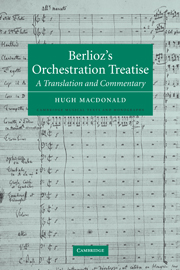Book contents
- Frontmatter
- Contents
- List of illustrations
- Preface
- A note on the edition
- A note on the translation
- Acknowledgments
- List of abbreviations
- The Treatise
- Introduction
- 1 Bowed strings
- 2 Plucked strings
- 3 Strings with keyboard
- 4 Wind: Introduction
- 5 Wind with reeds
- 6 Wind without reeds
- 7 Wind with keyboard
- 8 Brass with mouthpiece
- 9 Woodwind with mouthpiece
- 10 Voices
- 11 Pitched percussion
- 12 Unpitched percussion
- 13 New instruments
- 14 The orchestra
- 15 The conductor and his art
- Appendix: Berlioz's writings on instruments
- Bibliography
- General index
- Index of Berlioz's works
9 - Woodwind with mouthpiece
Published online by Cambridge University Press: 22 September 2009
- Frontmatter
- Contents
- List of illustrations
- Preface
- A note on the edition
- A note on the translation
- Acknowledgments
- List of abbreviations
- The Treatise
- Introduction
- 1 Bowed strings
- 2 Plucked strings
- 3 Strings with keyboard
- 4 Wind: Introduction
- 5 Wind with reeds
- 6 Wind without reeds
- 7 Wind with keyboard
- 8 Brass with mouthpiece
- 9 Woodwind with mouthpiece
- 10 Voices
- 11 Pitched percussion
- 12 Unpitched percussion
- 13 New instruments
- 14 The orchestra
- 15 The conductor and his art
- Appendix: Berlioz's writings on instruments
- Bibliography
- General index
- Index of Berlioz's works
Summary
THE SERPENT
This is an instrument with a mouthpiece made of wood covered with leather with the same range as the bass ophicleide but a little less agility, accuracy of intonation, or resonance. It has three notes, d, a and d′, much louder than the rest, and this causes some appalling unevenness of tone which players must do their best to correct. The serpent is in B♭. The range of the serpent is from B′ (sounding A′) chromatically up to c″ (sounding b♭′).
The fundamentally barbarous sound of this instrument would have been much more at home in the bloodthirsty rituals of the Druids than in those of the Catholic church, where it is always in evidence, a monstrous monument to the stupidity, tastelessness and lack of feeling which have guided the functions of music at divine service in our churches since time immemorial. An exception must be made for the occasions when the serpent is used to double the awesome Dies iræ plainchant at Requiem mass. Its cold, horrible bawling is doubtless appropriate there. It even seems to assume a kind of poetic misery as accompaniment to those words embodying all the horror of death and the vengeance of a jealous God. This implies too that it would be well suited to secular music concerned with the expression of such ideas – but only for that. Besides, it blends poorly with other orchestral and vocal timbres.
- Type
- Chapter
- Information
- Berlioz's Orchestration TreatiseA Translation and Commentary, pp. 242 - 245Publisher: Cambridge University PressPrint publication year: 2002

